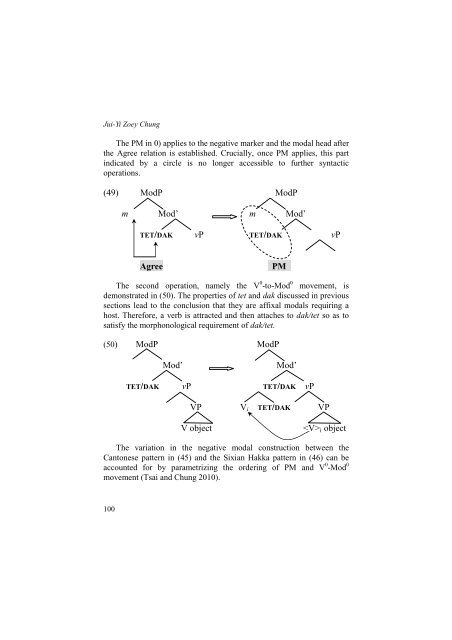investigating the syntax of postverbal modals in hakka
investigating the syntax of postverbal modals in hakka
investigating the syntax of postverbal modals in hakka
Create successful ePaper yourself
Turn your PDF publications into a flip-book with our unique Google optimized e-Paper software.
Jui-Yi Zoey Chung<br />
The PM <strong>in</strong> 0) applies to <strong>the</strong> negative marker and <strong>the</strong> modal head after<br />
<strong>the</strong> Agree relation is established. Crucially, once PM applies, this part<br />
<strong>in</strong>dicated by a circle is no longer accessible to fur<strong>the</strong>r syntactic<br />
operations.<br />
(49) ModP ModP<br />
100<br />
m Mod’ m Mod’<br />
TET/DAK vP TET/DAK vP<br />
Agree PM<br />
The second operation, namely <strong>the</strong> V 0 -to-Mod 0 movement, is<br />
demonstrated <strong>in</strong> (50). The properties <strong>of</strong> tet and dak discussed <strong>in</strong> previous<br />
sections lead to <strong>the</strong> conclusion that <strong>the</strong>y are affixal <strong>modals</strong> requir<strong>in</strong>g a<br />
host. Therefore, a verb is attracted and <strong>the</strong>n attaches to dak/tet so as to<br />
satisfy <strong>the</strong> morphonological requirement <strong>of</strong> dak/tet.<br />
(50) ModP ModP<br />
Mod’ Mod’<br />
TET/DAK vP TET/DAK vP<br />
VP Vi TET/DAK VP<br />
V object i object<br />
The variation <strong>in</strong> <strong>the</strong> negative modal construction between <strong>the</strong><br />
Cantonese pattern <strong>in</strong> (45) and <strong>the</strong> Sixian Hakka pattern <strong>in</strong> (46) can be<br />
accounted for by parametriz<strong>in</strong>g <strong>the</strong> order<strong>in</strong>g <strong>of</strong> PM and V 0 -Mod 0<br />
movement (Tsai and Chung 2010).


